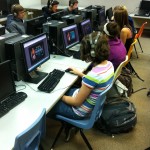I’ve read and heard how schools need to be held accountable. The politicians want some kind of proof that schools and teachers are educating children. Politicians try to convince the public that schools need to be held accountable to show that kids are achieving high standards of education. My goodness look at what newspapers publish! Test scores, school “grades,” teacher ratings. Whether individual kids are learning and growing doesn’t matter if they are not, “at standard.” That saddens me. It also saddens me that politicians and much of the public are convinced that a one-day-a-year, often multiple choice, standardized, one-size-fits-all test is going to inform anyone on how well kids are doing, how well teachers are doing, or how well schools are doing. If you are a parent or a politician and you want to know how schools are doing there are so many ways to find out other than checking standardized test scores. Ways that will give you much more information, nuanced and individualized.
Director General of Finland’s Education Ministry, Pasi Sahlberg, writes, “that whilst evidence of impact of such high-stakes school accountability policies to improve quality and efficiency of education remains controversial, the current practices of determining educational performance by using primarily standardised knowledge tests and examinations as main means of holding schools accountable for what they do is not a necessary condition of much needed educational improvement.” In Finland teachers are trusted to teach and schools are trusted to help all kids learn and grow. They don’t hand down standards to their schools and teachers and test them to death and yet Finnish students still perform better on international tests. There is something to be learned there no matter how different Finland is from the United States.
As a teacher having worked with kids aged 9 to 14, going on 22 years now, I know that standardized tests are not indicative of what kids know, what they are learning, how they are learning, how I am teaching, helping or supporting their learning, and how the school is doing. I’ve seen state tests in California and in Washington, from completely multiple choice (from IOWA even!) to a mix of multiple choice and short answer. While I think many of the tests that have short answer questions have good questions and are better than multiple choice tests I still know the results of such tests only tell a small piece of the whole picture that is a child’s education.
So out of 180 school days each year why not hold students work samples as more indicative of what they know and are learning? Not just one day of work samples, but samples from throughout the year. Why not let the kid choose which samples to share? Why not let the kid explain why he or she chose those samples and what they mean about his or her learning? Well, one reason is that test scores are more convenient, easier, to look at. It takes time, work and effort to see what a kid knows by looking at work samples and by talking to the kid. Yet which one is more accurate? I dare say that talking to a kid about the work samples he or she chose to share about what he or she is learning is even better than a letter grade, a percentage, or a class ranking. But that’s another topic.
One example of an alternative to test scores that I offer parents at our school’s end of October parent/student/teacher conferences is our class blog and how we use it as an electronic portfolio. After every activity, project, or lab I post follow-up questions or reflection questions to have kids reflect upon and/or share what they learned or are learning. So looking at any of my student’s blog at any time of the year you will have a sense of what assignments are being posted, which one the child has done, and by reading those you will get an idea of what that child is learning. Comparing earlier assignments to more recent assignments you can see how that child is growing in my class.
Sharing with parents how they can use their child’s blog throughout the year at that conference is cool but I have to admit that I think our second set of conferences is even way cooler. By the end of March we hold our annual Student-Led Conferences. We have advisory every day for about half an hour. Each advisory has around 15 6th, 7th, and 8th grade students. Advisories do different team building activities and kids stay with their same advisory for 6th, 7th, and 8th grade. Among the activities our advisories, called Eagle Time, do is to help kids maintain a portfolio and to prepare for their Student-Led Conference. Throughout the year the kids choose work samples from each class. They reflect on their work and prepare to talk about their growth, or lack of it, in each class. Then on the day of conference they come in with their family and they are completely in charge. Here’s a video my Eagle Time group made a few years back to show our incoming 6th graders what their Student-Led Conferences will look like:
I have been facilitating Student-Led Conferences like the ones above for the past six years. It is always a joy to watch the kids taking ownership of their education. I’m glad we offer both types of conferences so that the parents can talk to us, the teachers, and so that their kids can have a chance to be in charge. Imagine having kids do this whenever a politician wants to know how our school is doing? Parents enjoy having their child take charge of their education and explain how they are doing and where they are doing well and where they need to improve. So if you want to hold schools accountable ask the kids to show you how they are doing.



















































